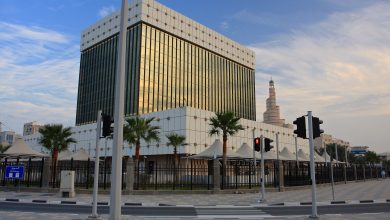QNB: Potential Growth in Emerging Markets Faces Significant Headwinds
بنك قطر الوطني: تحديات كبيرة تواجه الإصلاحات الهيكلية بالأسواق الناشئة
QNA
Doha: Qatar National Bank (QNB) said that the growth in emerging markets (EM) will continue to moderate in the coming years, given significant headwinds from weakening productivity and investment growth, the long-run deceleration of the Chinese economy, and stagnating global trade In its weekly commentary, QNB said, “Emerging markets (EM) have been a driver of global economic growth for many years. EM, defined as the group of countries that are in the process of rapid economic development, grew at rates that were three percentage points higher than those of the advanced economies for over two decades.
In fact, growth in EM accelerated sharply in the early 2000s from 5-year average rates that were below 4 percent, to a peak of 7.6 percent in 2007. Beneath these impressive aggregate figures, numerous examples showed that a country could sustain a rapid pace of development and catch-up to advanced economies if appropriate measures through policies and reforms are taken.
“The ascent of the Chinese economy accounted for an important part of this aggregate development, both directly and indirectly. Directly, given China’s significant weight in EM and growth rates of near 10 percent for several decades. Indirectly, as the effect on other economies materialised through supply-chain linkages, the demand for imported commodities, and a growing influence in international investment flows.
“However, the exceptional performance of EM began to lose strength after the Global Financial Crisis (GFC) in 2007-2008, and later faced significant volatility during the Covid-pandemic and the subsequent recovery. Importantly, we expect that growth will converge to more moderate rates of around 4 percent until 2030.
In this article, we analyse four main factors that will weigh on EM performance going forward.” The bank explained, “First, investment growth of capital in EM is expected to fall below the average rates of the last two decades. Previous periods of strong investment growth were supported by robust credit expansion, capital flows, improvements in terms of trade (prices of exports relative to imports), and reforms aimed to enhance the investment climate. During 2000-2010 investment growth in EM averaged 9.4 percent, but then dropped to 4.8 percent during 2011-2021.
This slowdown was extensive across all the EM regions and explained by factors including worsening terms of trade, elevated debt levels, higher economic and geopolitical uncertainty, and China’s rebalancing towards consumption and away from investment and exports. Importantly, we expect this trend to persist. Given the critical role of capital accumulation for growth, the slowdown in investment points to a major headwind in the coming years.
“Second, historically, international trade has been one of the pillars of global economic perfomance, given its positive impact on output and productivity growth. The process of global integration was boosted by regional trade agreements, multilateral negotiations, and unilateral trade reforms. As a result, trade in goods as a share of global GDP reached unprecedented levels in 2008.
Nevertheless, trade has stalled over the last decade driven by a trend towards de-globalization, which limits the margin for trade to give additional support to growth. Tariff reduction was an important driver of trade expansion previously, but now tariffs are already low on average in both advanced and emerging economies.
Additionally, structural factors, such as the rebalancing of economies towards services, will naturally reduce the weight of trade in the economy. This process will weaken the role of goods trade as a growth engine in coming years.
“Third, the Chinese economy is undergoing a significant deceleration relative to its performance in previous decades, diminishing its role as a global growth driver. After 40 years of soaring growth rates averaging 9.5 percent during 1980-2019, this pace is likely to fall below 5 percent on average.
The slowdown is driven by numerous structural factors including demographic headwinds, declining productivity growth, high debt levels, a slower pace of structural reforms, and the rising threat of geo-economic fragmentation.
Given the importance of the Chinese economy for EM growth through direct and indirect channels, the slowdown in China implies an important challenge in the coming years.
“Finally, the broad-based slowdown in productivity growth in EM is expected to continue, adding another drag to economic growth. According to estimates by the World Bank, productivity in EM grew at an average rate of 2.2 percent in the period 2000-2010, and decelerated to 1.6 percent in 2011-2021. This trend will further consolidate, with average productivity growth declining to 1.4 percent during 2022-2030.
The slowdown in productivity growth is due to various factors, including the deceleration in working-age population and educational attainment growth, and a smaller productivity gap with advanced economies which implies a weaker “catch-up” process.
Furthermore, the extent to which EM will be able to leverage artificial intelligence to reverse the decline in productivity growth is highly uncertain.” The bank concluded, “All in all, after two decades of exceptional performance, growth in EM will continue to moderate in the coming years, given significant headwinds from weakening productivity and investment growth, the long-run deceleration of the Chinese economy, and stagnating global trade.
This raises the bar for the structural reforms needed by developing countries to continue their process of catch-up to advanced economies.”
قنا
الدوحة: أكد بنك قطر الوطني “QNB” أن الإصلاحات الهيكلية، التي تحتاجها البلدان النامية لمواصلة عملية اللحاق بركب الاقتصادات المتقدمة، تواجه تحديات كبيرة، تتمثل بتباطؤ الاقتصاد الصيني على المدى الطويل، وركود التجارة العالمية، والرياح المعاكسة القوية الناجمة عن ضعف الإنتاجية وتراجع نمو الاستثمار.
وتوقع البنك في تقريره الأسبوعي، أن يستمر التباطؤ واسع النطاق في نمو الإنتاجية بهذه الأسواق، ما يضيف عائقا آخر للنمو الاقتصادي. ووفقا لتقديرات البنك الدولي، نمت الإنتاجية فيها بمعدل متوسط بلغ 2.2 بالمئة في الفترة من 2000 إلى 2010، ثم تباطأت إلى 1.6 بالمئة في الفترة من 2011 إلى 2021، وسيتعزز هذا الاتجاه بشكل أكبر، مع انخفاض متوسط نمو الإنتاجية إلى 1.4 بالمئة خلال الفترة من 2022 إلى 2030.
وعزا التقرير تباطؤ نمو الإنتاجية إلى عوامل مختلفة، بما في ذلك تباطؤ نمو عدد السكان في سن العمل، وضعف نمو التحصيل التعليمي، وتضييق فجوة الإنتاجية مع الاقتصادات المتقدمة، ما يعني ضمنا تراجع عملية اللحاق بركبها، علاوة على ذلك، فإن قدرة الأسواق الناشئة على الاستفادة من الذكاء الاصطناعي للتصدي لتراجع نمو الإنتاجية أمر غير مؤكد إلى حد كبير.
وأكد أنه بعد عقدين من الأداء الاستثنائي، سيستمر النمو في الأسواق الناشئة بالاعتدال، خلال السنوات المقبلة، نظرا للرياح المعاكسة القوية، والتباطؤ الصيني، وركود التجارة العالمية، وهذا من شأنه أن يزيد التحديات أمام الإصلاحات المنشودة.
وأضاف التقرير أن الأسواق الناشئة كانت محركا للنمو الاقتصادي العالمي لسنوات عديدة، وحققت هذه الأسواق، التي تعرف بأنها مجموعة البلدان التي تمر بمرحلة تنمية اقتصادية سريعة، نموا بمعدلات أعلى بثلاث نقاط مئوية من نظيراتها في الاقتصادات المتقدمة لأكثر من عقدين من الزمن، حيث تسارع النمو فيها بشكل قوي في أوائل العقد الأول من القرن الحادي والعشرين من معدل متوسط ??لخمس سنوات يقل عن 4 بالمئة إلى ذروة بلغت 7.6 بالمئة في 2007.
ولفت إلى أن صعود الاقتصاد الصيني شكل جزءا مهما من هذه التطورات الكلية، سواء بشكل مباشر أو غير مباشر، ويتمثل التأثير المباشر في ثقل وزن الصين بالأسواق الناشئة وتحقيقها لمعدلات نمو تقترب من 10 بالمئة لعدة عقود، أما الجانب غير المباشر، فيتمثل في التأثير على الاقتصادات الأخرى من خلال روابط سلسلة التوريد، والطلب على السلع المستوردة، والتأثير المتزايد في تدفقات الاستثمار الدولي.
وأشار التقرير، إلى أن الأداء الاستثنائي للأسواق الناشئة بدأ يفقد قوته بعد الأزمة المالية العالمية في الفترة 2007 – 2008 ، وواجهته لاحقا تقلبات كبيرة خلال جائحة كوفيد-19 وفي فترة التعافي منها.
كما توقع أن يقترب نمو الأسواق الناشئة من معدلات أكثر اعتدالا تبلغ حوالي 4 بالمئة حتى عام 2030، استنادا إلى ثلاثة عوامل رئيسة من شأنها أن تؤثر على أدائها مستقبلا: أولا، من المتوقع أن ينخفض ??نمو استثمارات رؤوس الأموال بالأسواق الناشئة إلى أقل من متوسط ??معدلات العقدين الماضيين، حيث كانت الفترات السابقة من النمو الاستثماري القوي مدعومة بالتوسع الائتماني الكبير، وتدفقات رؤوس الأموال، والتحسينات في معدلات التجارة، والإصلاحات الرامية إلى تعزيز المناخ الاستثماري، وخلال الفترة من 2000 إلى 2010، بلغ متوسط ?? النمو الاستثماري فيها 9.4 بالمئة، لكنه انخفض إلى 4.8 بالمئة خلال الفترة من 2011 إلى 2021.
وكان هذا التباطؤ واسع النطاق في جميع مناطق الأسواق الناشئة، وتم تفسيره بعوامل تشمل تدهور معدلات التبادل التجاري، وارتفاع مستويات الديون، وتزايد عدم اليقين الاقتصادي والجيوسياسي، وإعادة التوازن في الصين نحو الاستهلاك والابتعاد عن الاستثمار والصادرات، وفي السياق من المتوقع أن يستمر هذا الاتجاه، نظرا للدور الذي يلعبه تراكم رؤوس الأموال في تحقيق النمو، كما أن تباطؤ الاستثمار يشير إلى رياح معاكسة كبيرة في السنوات المقبلة.
ثانيا، ظلت التجارة الدولية تاريخيا إحدى ركائز الأداء الاقتصادي العالمي، نظرا لتأثيرها الإيجابي على نمو الناتج والإنتاجية، وتعززت عملية التكامل العالمي بفضل اتفاقيات التجارة الإقليمية، والمفاوضات متعددة الأطراف، والإصلاحات التجارية أحادية الجانب، ونتيجة لذلك، وصلت تجارة السلع كحصة من الناتج المحلي الإجمالي العالمي إلى مستويات غير مسبوقة في 2008، ومع ذلك، تباطأت التجارة خلال العقد الماضي بسبب تراجع العولمة الذي يحد من قدرة التجارة على تقديم دعم إضافي للنمو.
وكان تخفيض التعريفات الجمركية محركا للتوسع التجاري في السابق، والآن، متوسط التعريفات منخفض في كل من الاقتصادات المتقدمة والناشئة، بالإضافة إلى ذلك، فإن العوامل الهيكلية، كإعادة توازن الاقتصادات نحو الخدمات، ستؤدي إلى تقليل وزن التجارة في الاقتصاد، ومن شأن هذه العملية أن تضعف دور تجارة السلع كمحرك للنمو في السنوات المقبلة.
ثالثا، يشهد الاقتصاد الصيني تباطؤا كبيرا مقارنة بأدائه في العقود السابقة، مما يقلص دوره كمحرك للنمو العالمي، فبعد 40 عاما من النمو، الذي بلغ متوسطه 9.5 بالمئة خلال الفترة 1980 – 2019، يرجح أن تنخفض هذه الوتيرة إلى أقل من 5 بالمئة في المتوسط، ويعود هذا التباطؤ إلى عوامل هيكلية وديموغرافية، وتراجع نمو الإنتاجية، وارتفاع مستويات الديون، وتباطؤ وتيرة الإصلاحات الهيكلية، والتهديد المتزايد المتمثل في التفتت الجغرافي الاقتصادي، ونظرا لأهمية الاقتصاد الصيني بالنسبة لنمو الأسواق الناشئة من خلال القنوات المباشرة وغير المباشرة، فإن التباطؤ في الصين يشير ضمنا إلى تحديات مهمة في السنوات المقبلة.




